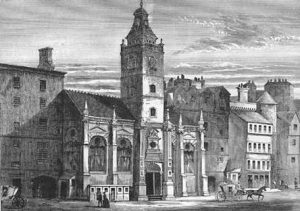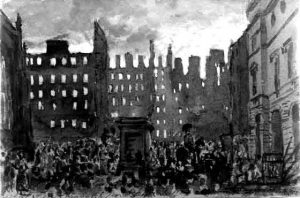We have all been horrified by the tragedy of the fire at Grenfell Tower in London. The scale of loss is not yet known but we fear it is expected to increase significantly in the coming days. This type of fire is something that we have every right to expect should not happen in a modern, rich country such as the United Kingdom. Major fires with high loss of life have dotted our history including the Glen Cinema in Paisley in 1929 where 71 children lost their lives or the Cheapside Whisky Bond fire in Glasgow in 1960 which led to the tragic loss of 19 fire fighters.
The power of a major fire is an incredible and horrifying sight for anyone who has witnessed one. As a former police officer I remember in my early years of service in the late eighties being on duty at some major fires including the Wolfcraig Shopping Centre in Stirling. Thankfully the frequency of such large scale fires seemed to have become a thing of the past as modern building design and fire suppression systems appeared to have help dismiss them to history. The tragic events we have witnessed in London are a horrifying reminder of how things must have been in the past and the real day by day fear of fire our ancestors must have felt.
There is little doubt that the Grenfell Tower tragedy will become an iconic moment in terms of high rise building design and critically, how we treat the poorest people who live in our social housing. Throughout our history we have experienced many incidents where society collectively paused, drew a breath and agreed to change direction. Tragedies such as Piper Alpha for off-shore Health and Safety standards and Dunblane for the madness of poor gun control are just some examples where we all collectively said enough was enough and made major changes to how we were as a society. Hopefully we will make the changes necessary to prevent another Grenfell Tower from happening again and treat the poorest in our society better than we have done here.
If we look back in our history we can also identify similar moments experienced by our ancestors which helped change our society, largely for the better. Through many of the resources available to genealogists including newspaper archives and maps such as in the National Library of Scotland collection, we can learn more about these incidents.
One example has been termed “The Great Fire of Edinburgh”. This took place between the 15 and 17 November 1824. If you look at a map of Edinburgh of that time, such as John Kirkwood’s map of Edinburgh shown below (National Library of Scotland) you will see that the area around the High Street in Edinburgh comprised of narrow closes and streets. The buildings were built of wood, poorly maintained and housed some of the poorest people of the city whilst ironically rubbing shoulders with many of the city’s grandest buildings including the Tron Kirk and Signet Library. The tenements were in some instances 9 or 10 stories high with a very high occupant density.

Source:Kirkwood, James, 1745/6-1827. Plan of Edinburgh, 1821. http://maps.nls.uk/view/74401133.
Edinburgh’s equivalent of The Great Fire of London’s Pudding Lane was a tenement occupied by either a Mr Kirkwood or Mrs MacDonald (dependent on accounts) at Old Assembly Close off the High Street. Today that is next to where the Edinburgh Fringe Shop is located. An article in the Scotsman Newspaper found on the British Newspaper Archives reported that initially the fire was confined to that tenement. It was described rather disdainfully, in the style of so-called well informed observers who have never dealt with such an incident (we have an abundance of them today!!) as “very ordinary exertions would be sufficient to subdue the fire”. The Scotsman was critical of the lack of effort by the fire brigade and in time this would be a major theme of the fire – the need for greater co-ordination and professionalism when fighting fires. This could not be in more sharper contrast to the bravery and exceptional service of London Fire Bridge at Grenfell Tower.
Whatever happened the fire began to spread, helped by the wooden construction of the tenements and their close proximity to each other. The Scotsman Printing offices was nearby and the article,from the Scotsman of 17 November 1824 reported that in time “heat was so intense it was not possible to expose the face to it for any length of time”. People from the surrounding streets began to evacuate their homes as the fire began to leap from tenement to tenement, particularly in the area around Old Fishmarket Close which is still in position today, close to Parliament Square.
We may have learned the lessons from the past in terms of fire fighting but it is questionable whether we have learned much from our social housing management policies and ethos. The sights we have seen in recent days in Grenfell should make us feel a sense of shame about how we deal with the poorest in our society. Time will judge what went wrong in London but you cannot help see the similarities in the fire in Edinburgh almost 200 years ago when the Scotsman article reported “Pity was excited by condition of the poor – men, women & children driven from their house, carrying in their hands some miserable remnant of their furniture.” Again it was the poorest residents of Edinburgh who paid the highest price for the fire.

Source: www.royalmilemarket.co.uk/index.php/tourist-info-desk/tron-kirk-history )
The initial fire, located around Old Fishmarket Close finally extinguished itself when it met a large stone built building. However another fire then broke out around the Tron Kirk area in the High Street, probably due to sparks from the other fire. In the wonderful reporting style of newspapers of that time, the article described how a cry from the crowd reported that the wooden spire of the Tron Kirk was alight and rivers of lead flashing which covered the spire were seen running down the side of the building. The wooden spire was eventually fully alight and collapsed in on itself. The actual church building itself survived largely intact.
This fire was finally extinguished and just as it looked like the fire was over, the wooden construction of many of the buildings caused another outbreak. This fire was at “the high old tenement at the south-east corner of Parliament Square”. The fire started at the top floor and eventually the entire building was burning and by 3am on the morning of the 17th November “all its floors and wooden work were burned down to the foundation.” The fire continued to threaten other areas of Edinburgh due to the flying sparks but were finally extinguished.

Source: National Galleries of Scotland
The final assessment of the fire was that eleven people and two fire fighters died and many more suffered serious injuries. It was estimated that between four and five hundred families were made homeless. The cost of the fire was around £200,000 which in today’s costs would be estimated as around £16 million, although that perhaps ignores modern Edinburgh property prices!! The fire left longer lasting legacies. The Old Town and the area around Parliament Square was re-built with stone tenements, although conditions for the poorer families living in the tenements remained very poor until later in the nineteenth century.
The real legacy was in the delivery of a professional fire brigade. The fire engines that responded were owned by different insurance companies and it was reported that there was often fierce professional rivalries between different fire crews leading to differing priorities and poor deployment of fire engines to tackle the fire. As a result of the Great Fire there was a renewed push to improve the service for all citizens and thus Edinburgh became one of the first (some say the first) to have a proper local fire brigade.
From these early beginnings developed the bravery and professionalism we have all witnessed in the last few days in London reflecting our modern Fire Service.
Sources
- The Scotsman (1824) Disastrous and Extensive Fire. 17 November 1824. p1a-c. British Newspaper Archives: www.findmypast.co.uk.
- Kirkwood, James, 1745/6-1827. Plan of Edinburgh, 1821. National Library of Scotland: http://maps.nls.uk/view/74401133.
- The Royal Mile Market. The Tron Kirk will celebrate its 350th anniversary in 2017: www.royalmilemarket.co.uk/index.php/tourist-info-desk/tron-kirk-history
- Measuring Worth: https://www.measuringworth.com/ppoweruk/
- The National Galleries of Scotland: https://www.nationalgalleries.org/
- Reid, Alexander. The History of Edinburgh Fire Brigade : www.electricscotland.com
Recent Comments